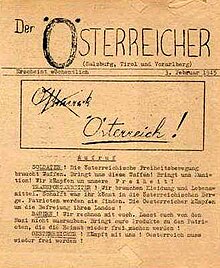Operation sauerkraut
The operation sauerkraut was a measure of operational information that during the Second World War from July 1944 until at least March 1945 by the American Office of Strategic Services was planned (OSS) and carried out. The aim was to enable Allied propaganda material to be disseminated quickly through the use of German prisoners of war .


The idea of using German prisoners of war as agents came about after the unsuccessful assassination attempt on Adolf Hitler on July 20, 1944 . Taking advantage of this unexpected psychological advantage, the use of apparently German soldiers in Wehrmacht uniforms was considered particularly suitable for indoctrating the enemy without wasting much time .
In a POW camp for Germans near Naples , efforts were made to win over the first candidates for the mission. At the same time, appropriate leaflets were developed that refer to the attempted coup on July 20 and were then to be smuggled into Germany. So was z. B. claims that Walther von Brauchitsch took over command in Germany or asked the German troops to carry out revolutionary measures against the Nazi regime . An extra edition of the magazine Das Neue Deutschland was also produced, which referred to alleged opposition groups within the German Reich .
After initially 16 trustworthy prisoners of war had been selected, they were first transported to Rome to be equipped accordingly. This included a. German Wehrmacht uniforms, forged documents, weapons and compasses . Money in Italian currency , cigarettes and first aid equipment were also included. They were then smuggled in in small groups across the Arno River . They were supposed to penetrate as deeply as possible behind the German lines and spread the propaganda material they were given. For example, leaflets and magazines should be attached to trees, distributed in vehicles, in buildings and on streets.
The forged documents that were given to the agents were of particular importance. Since there were constant changes to certain identification features on the German side for security reasons, the US side had to make regular improvements, which apparently worked extremely well. Although agents of the operation were reported to have been checked by German military police on several occasions , there was only one case in which such an agent was exposed. While the forged documents had to look as perfect as possible - this also included forged party books including the party fee stamps - the propaganda material provided was deliberately printed in a much coarser quality. In this way the impression should be avoided that the stickers, leaflets or magazines are material made abroad by the enemy with high-quality printing machines.
In total, about 13 missions of Operation Sauerkraut were carried out. For this purpose, small groups were smuggled behind the German lines from July 25, 1944 until at least March 21, 1945.
Since under international law prisoners of war may not be deliberately brought into dangerous situations, all employees of Operation Sauerkraut had to sign a declaration certifying their voluntary participation. US lawyers considered this to be indispensable if lawsuits were brought against the US Army in an international court of law after the war . Although the German agents of the operation were promised preferential treatment by the US for their services, they were merely returned to the usual prisoner of war camps after their work. There they were avoided by fellow prisoners after knowing that they were agents and despised as traitors.


